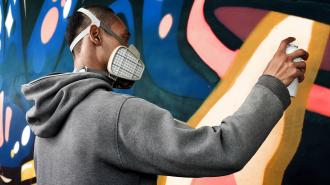Digital artists aren’t the only ones benefiting from non-fungible tokens (NFTs) — street artists are now using the tokens to earn money, reach new audiences, and extend the life of their street art.
The challenge: Instead of working on canvases, street artists paint on bridges, buildings, and other publicly viewable surfaces, sometimes spending weeks on murals that require incredible creativity and talent.
But for every Banksy with millions of dollars in the bank, there are countless artists who aren’t making anything off of their work. They create something stunning, the public gets to enjoy it for a while, and then it gets painted over or simply fades in response to the elements.
“By scanning a mural and turning it into an NFT, we forever immortalize the art.”
Rachel Wolfe-Goldsmith (aka Wolfe Pack)
Permanent street art: NFTs are digital records stored on a blockchain. Each is linked to a specific digital item, such as an image or video, and if you own an NFT, you “own” the item it’s linked to — others might have copies, but you have the original.
NFTs have become a big deal in the art world as they’re allowing digital artists to sell “originals” of their works. This offers a kind of scarcity and status, and some prices have gone into the millions.
“It’s a massive audience that is getting bigger and bigger every day.”
Marco Calamassi
Companies like Streeth and the NFT Mural Collective are now helping street artists get into NFTs, walking them through the process of scanning their street art, linking it to a token, and then selling it.
“Buildings can crumble, weather can cause damage, and developments can impede views,” artist Rachel Wolfe-Goldsmith (aka Wolfe Pack) told Wired. “By scanning a mural and turning it into an NFT, we forever immortalize the art.”
The benefits: In addition to preserving street art on the blockchain and potentially providing creatives with a new source of income, NFTs could also help the artists reach more people.
“NFTs broaden an artist’s audience because they’re not only targeting street art fans, they’re targeting NFT fans, digital art fans, and crypto fans,” Streeth co-founder Marco Calamassi told Wired. “It’s a massive audience that is getting bigger and bigger every day.”
The increased reach doesn’t have to end after the NFT is sold either.
As Gita Joshi, an independent art curator, told Wired, some NFT owners might choose to use the street art to decorate their own corners of the emerging metaverse. Visitors to that virtual world might then encounter the art by surprise — the same way people do on city streets today.
We’d love to hear from you! If you have a comment about this article or if you have a tip for a future Freethink story, please email us at [email protected].






